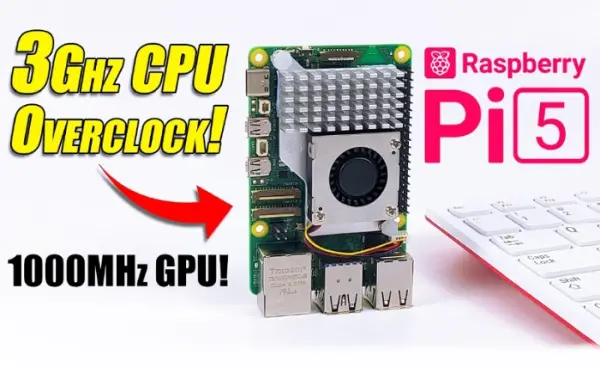The new Raspberry Pi 5 is now available to preorder and will soon be in the hands of enthusiasts worldwide. If you are looking to get the most power from your mini PC you might be interested in overclocking your system. This quick guide and accompanying videos provides insight into how to overclock your Raspberry Pi 5 to 3 GHz and beyond.
Overclocking the Raspberry Pi 5 to 3 gigahertz is a fascinating exploration into the realm of hardware optimization. This process, which involves pushing the device’s CPU beyond its factory-set limits, can significantly enhance the performance of this already impressive piece of technology.
The Raspberry Pi 5, the latest iteration of the popular single-board computer, comes equipped with a quad-core SOC running at 2.4 gigahertz using Cortex A76 cores. However, with a bit of tweaking, this device can be overclocked to reach a staggering 3 gigahertz on the CPU and 1 gigahertz on the GPU. This process can be accomplished using a Windows PC, Mac, or Linux machine, making it accessible to a wide range of users.
How to over clock a Raspberry Pi 5
Watch the videos below to learn more about the process of overclocking the Raspberry Pi 5, testing its performance, comparing it to non-overclocked versions, and examining its real-world applications.
The overclocking process primarily involves adjusting the config.txt file on the Raspberry Pi’s boot partition. This file contains various settings that control the device’s hardware, including the CPU and GPU frequencies. By modifying these settings, users can push the Raspberry Pi 5 beyond its default limits and unlock its full potential.
Once the Raspberry Pi 5 has been overclocked, the difference in performance is immediately noticeable. The device becomes significantly faster and more responsive, handling tasks with greater efficiency. For instance, the overclocked Raspberry Pi 5 can handle 1080p playback from YouTube, albeit with some frame drops. This is a considerable improvement over the non-overclocked version, which may struggle with such demanding tasks.
Benchmark tests further illustrate the benefits of overclocking the Raspberry Pi 5. When compared to the Raspberry Pi 4 and the non-overclocked Raspberry Pi 5, the overclocked version outperforms both in terms of decompression, multi-thread CIS bench, Speedometer browser benchmark, and Geekbench. These results demonstrate the tangible improvements that overclocking can bring to the Raspberry Pi 5’s performance.
Pi 5 overclocking
The overclocked Raspberry Pi 5 also excels in real-world tests. For example, it can run Minecraft and emulate games with relative ease, showcasing its enhanced capabilities. These tests provide a practical demonstration of the device’s improved performance, highlighting the benefits of overclocking in everyday use.
Despite the increased performance, the Raspberry Pi 5’s CPU temperature remains under the thermal throttle limit even when overclocked and maxed out. This is an important consideration, as overheating can lead to hardware damage and reduced lifespan. Therefore, it’s reassuring to know that the Raspberry Pi 5 can handle the increased demands of overclocking without overheating.
In addition to overclocking the CPU, the Raspberry Pi 5’s performance can be further improved by overclocking the GPU. This can lead to even better performance, particularly in graphics-intensive tasks. However, this process requires additional steps and should be undertaken with caution to avoid damaging the device.
Overclocking the Raspberry Pi 5 to 3 gigahertz can significantly enhance its performance, making it faster and more responsive. Whether you’re running benchmark tests or playing games, the benefits of overclocking are clear. However, it’s important to monitor the device’s temperature and ensure it doesn’t overheat. With careful management, the Raspberry Pi 5 can be a powerful tool for a wide range of applications.
Source: How to overclock a Raspberry Pi 5 to 3GHz and beyond


